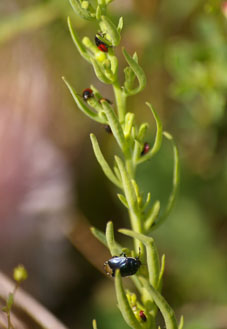Habitat quality and landscape factors
- how do they affect the distribution of a specialized insect?
A major threat to global biodiversity today is fragmentation and loss of natural habitat. This leads to
smaller habitat areas that are more isolated from each other and makes life hard for species living
there.
Many insect species are especially vulnerable because they often have very specific requirements
and cannot move long distances.
The distribution of a species can be influenced by factors at both local and landscape scales, but
knowledge about how different spatial scales affect species is often lacking.
The aim of my project was to assess how a monophagous insect (an insect that only feeds on one specific host plant species) is affected by the quality and spatial configuration of its host plant. I conducted my study at three spatial scales; plant, patch (plant group) and landscape to see how factors at different spatial scales influenced the species.
The species in this study

Adult and nymphs of Canthophorus impressus on a Thesium alpinum plant.
Canthophorus impressus is a shield bug that in Sweden only lives on the perennial plant Thesium alpinum. The global distribution ranges from the British Isles through Europe to Siberia. In Sweden it is restricted to the south-eastern parts, mainly the provinces of Småland and Östergötland, following the distribution of its host plant. The adults of C. impressus overwinter as clusters in the leaf litter near the host plants. Mating occurs in May and eggs are probably laid in or on the ground beneath a host plant, similarly to other related species. The nymphs (young bugs) appear in June and are completely developed in July-August. Habitat requirements of the shield bug are largely unknown.
Thesium alpinum grows mainly on nutrient-poor, sandy open grasslands like unfertilized pastures and meadows, but has also been found on other types of open land, such as road verges. It depends on soil disturbance for its regeneration, which can be achieved by grassland management, typically grazing or mowing. Its distribution in Sweden is fragmented due to the large area reduction of nutrient-poor (so-called semi-natural) grasslands during the last century.
Both species are red listed as near threatened (NT) in Sweden, and the shield bug is the subject of a recent action plan from the Swedish Environmental Protection Agency.
Responsible for this page:
Director of undergraduate studies Biology
Last updated:
05/15/12
